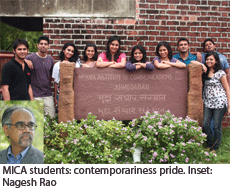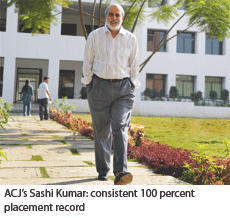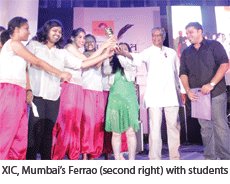As Indian companies and foreign media conglomerates continue to make massive investments in print, television and online media platforms, job opportunities for professionals are exploding. Here are India’s best Mass Communication Institutes for the year 2013:
 With over 500 television channels, 50,000 newspapapers and magazines, hundreds of advertising agencies and public relations firms, the media and communications industries are booming in India. A 2011 PricewaterhouseCoopers report estimates that the media and entertainment industry in India is set to grow at an annual rate of 13.2 percent over 2011-15 to hit Rs.119,900 crore. As Indian corporates and foreign media conglomerates continue to make massive investments in media infrastructure including print, television, radio and online platforms, job opportunities for trained professionals are exploding in this industry.
With over 500 television channels, 50,000 newspapapers and magazines, hundreds of advertising agencies and public relations firms, the media and communications industries are booming in India. A 2011 PricewaterhouseCoopers report estimates that the media and entertainment industry in India is set to grow at an annual rate of 13.2 percent over 2011-15 to hit Rs.119,900 crore. As Indian corporates and foreign media conglomerates continue to make massive investments in media infrastructure including print, television, radio and online platforms, job opportunities for trained professionals are exploding in this industry.
Unsurprisingly over the past two decades since liberalisation, the number of mass communication institutes has multiplied. While most of the country’s 659 universities have introduced under-graduate and postgrad degree programmes in media and communication, specialised institutions offering industry-validated diploma programmes have also mushroomed. In the inaugural EducationWorld-C fore Mass Communication Institutes Rankings 2013, we have rated and ranked India’s Top 15 institutions.
Ranked India’s #1 mass communication institution with an aggregate score of 567 of 650 is the pioneer Mudra Institute of Communications, Ahmedabad (MICA), promoted in 1991 to “meet the integrated marketing communication needs of industry, government and community”. A wholly residential institution specialising in training communications management professionals, MICA has been top-ranked by the sample respondents comprising industry representatives, faculty and students on all four parameters of excellence including competence of faculty, pedagogic systems and processes, placements and infrastructure and support systems.
This 22-year-old institute’s flagship programme is its two-year postgrad diploma in communications management with specialisations in brand, media (including new media), advertising management and marketing research, and is equivalent to MBA certification.
While delighted with the numero uno ranking awarded by informed respondents, MICA spokespersons stress that the institute is focused on ‘communications management’ and not ‘mass communications’ and hence is misclassified. However, this misgiving is unfounded as for the purposes of this survey, mass communications has been defined in a broader sense encompassing print, television, radio and online journalism, media management, marketing communications, advertising and public relations.
“It’s gratifying to be acknowledged as India’s premier institute for communications management in a competitive, research-based and external ranking. This #1 ranking imposes a responsibility upon us to continue to improve. Over the years MICA has grown from less than 50 postgrad students to over 300 today, and our alumni occupy leadership positions in industry in India and abroad. MICA assures students delivery of current, reliable, and cost-effective communication management skills. Our distinguishing feature is our contemporariness because we keep abreast of trends in an ever-changing environment,” says Dr. Nagesh Rao, director of MICA. The average starting salary offered in 2012 to MICA graduates was Rs.9.2 lakh per year with the highest campus recruitment offer topping Rs.19.6 lakh.
 Ranked a close second on the league table of India’s best Mass Communication Institutes 2013 with an aggregate score of 562 is the Chennai-based Asian College of Journalism (ACJ). Founded in 1994 in Bangalore by the Indian Express group, ACJ was sold in 2000 to the Media Development Foundation, a not-for-profit trust promoted by Sashi Kumar, a veteran journalist (The Hindu, Frontline, Press Trust of India) and founder of Asianet (estb. 1992), India’s first satellite channel. After changing hands and moving to Chennai, ACJ expanded its one-year postgrad diploma specialisations from print to include television, new media and radio journalism. Currently 180 students learn the ropes of journalism at its state-of-the-art campus offering 10 computer labs, a well-stocked library, print and new media edit desks with the latest production software, and two digital TV studios with excellent broadcast and editing facilities. Moreover on-campus hostels accommodate 138 students.
Ranked a close second on the league table of India’s best Mass Communication Institutes 2013 with an aggregate score of 562 is the Chennai-based Asian College of Journalism (ACJ). Founded in 1994 in Bangalore by the Indian Express group, ACJ was sold in 2000 to the Media Development Foundation, a not-for-profit trust promoted by Sashi Kumar, a veteran journalist (The Hindu, Frontline, Press Trust of India) and founder of Asianet (estb. 1992), India’s first satellite channel. After changing hands and moving to Chennai, ACJ expanded its one-year postgrad diploma specialisations from print to include television, new media and radio journalism. Currently 180 students learn the ropes of journalism at its state-of-the-art campus offering 10 computer labs, a well-stocked library, print and new media edit desks with the latest production software, and two digital TV studios with excellent broadcast and editing facilities. Moreover on-campus hostels accommodate 138 students.
“Our one-year journalism education programme is unique with students given the option of topping up the diploma by completing a dissertation project at Cardiff University, or in Chennai for the award of a Masters in journalism of Cardiff. Our excellent full-time and part-time faculty drawn from the academic and professional world is our biggest asset. We have had a consistent 100 percent placement record even during the recessionary years. Our graduates are readily absorbed by the country’s top media houses including Times of India, The Hindu, NDTV, CNN-IBN etc,” says Kumar, chairman of the Media Development Foundation and ACJ.
 Another West coast institution which enjoys a national reputation for training industry-ready media professionals is the Xavier Institute of Communication, Mumbai, ranked #5. Promoted in 1969 and sited within the campus of the 144-year-old Jesuit-run St. Xavier’s College, Mumbai — widely acknowledged as among the country’s top liberal arts colleges — XIC began with offering evening courses in radio, journalism, and cinema. Now it offers full-time and part-time diploma programmes in journalism and mass communication; advertising and marketing communications; public relations; film, TV and digital video production and communications for development (in association with Unicef), to 230 students.
Another West coast institution which enjoys a national reputation for training industry-ready media professionals is the Xavier Institute of Communication, Mumbai, ranked #5. Promoted in 1969 and sited within the campus of the 144-year-old Jesuit-run St. Xavier’s College, Mumbai — widely acknowledged as among the country’s top liberal arts colleges — XIC began with offering evening courses in radio, journalism, and cinema. Now it offers full-time and part-time diploma programmes in journalism and mass communication; advertising and marketing communications; public relations; film, TV and digital video production and communications for development (in association with Unicef), to 230 students.
“Our Top 5 ranking is great news. The credit for our high ranking should go to our dean, Dr. J.B. Mistry, and versatile and highly-qualified faculty who contribute fresh and innovative ideas drawn from industry. Excellent teaching is supported by state-of-the-art facilities including the Cardinal Gracias Media Resource Centre which is the best mass media communications library in the city; a modern sound studio; three computer labs and a mini film studio which helps students to learn by doing. Even though XIC doesn’t have a placements cell, most of our graduates get placed within a month of completion of their study programmes,” says Fr. Lawrence Ferrao SJ, director of XIC.
An interesting highlight of the league table of India’s Top 15 mass communication institutes is that though a majority of the country’s 659 universities offer postgraduate programmes in mass communication, only four university departments are ranked within the Top 15. They are the A.J. Kidwai Mass Communication Research Centre, Jamia Millia Islamia University, Delhi (#3); Symbiosis Institute of Mass Communication, Symbiosis International University, Pune (#7); Sarojini Naidu School of Arts & Communication, University of Hyderabad (#8) and Department of Communication and Journalism, Pune University (#14).
The all-India league table is dominated by independent private sector institutions offering diploma programmes, indicating that industry validation and interface are strong deciding factors determining institutional reputations in new age professional education.
To see the Top 15 league table visit http://www.educationworld.in/rank-mass_communication/2013.html























